Comprehensive Audit Report: Select Harvests Limited Financial Analysis
VerifiedAdded on 2023/01/11
|13
|2320
|29
Report
AI Summary
This report provides a comprehensive audit analysis of Select Harvests Limited. It begins by determining the appropriate level of materiality for the 2019 audit, discussing the nature of materiality, its significance in financial statement audits, and the considerations for its determination, including a quantitative estimate. The report then reviews various draft notes and disclosures, highlighting significant aspects like contingencies and outlining necessary audit procedures. Furthermore, the report analyzes audit assertions, including account balances, classes of transactions, and presentation and disclosure, using ratio analysis to identify potential misstatements and related audit procedures. Finally, the report reviews the cash flow statement, analyzing cash inflows and outflows from operating, investing, and financing activities, and assessing the company's going concern risk, concluding with an overview of the company's financial position and compliance with accounting standards.
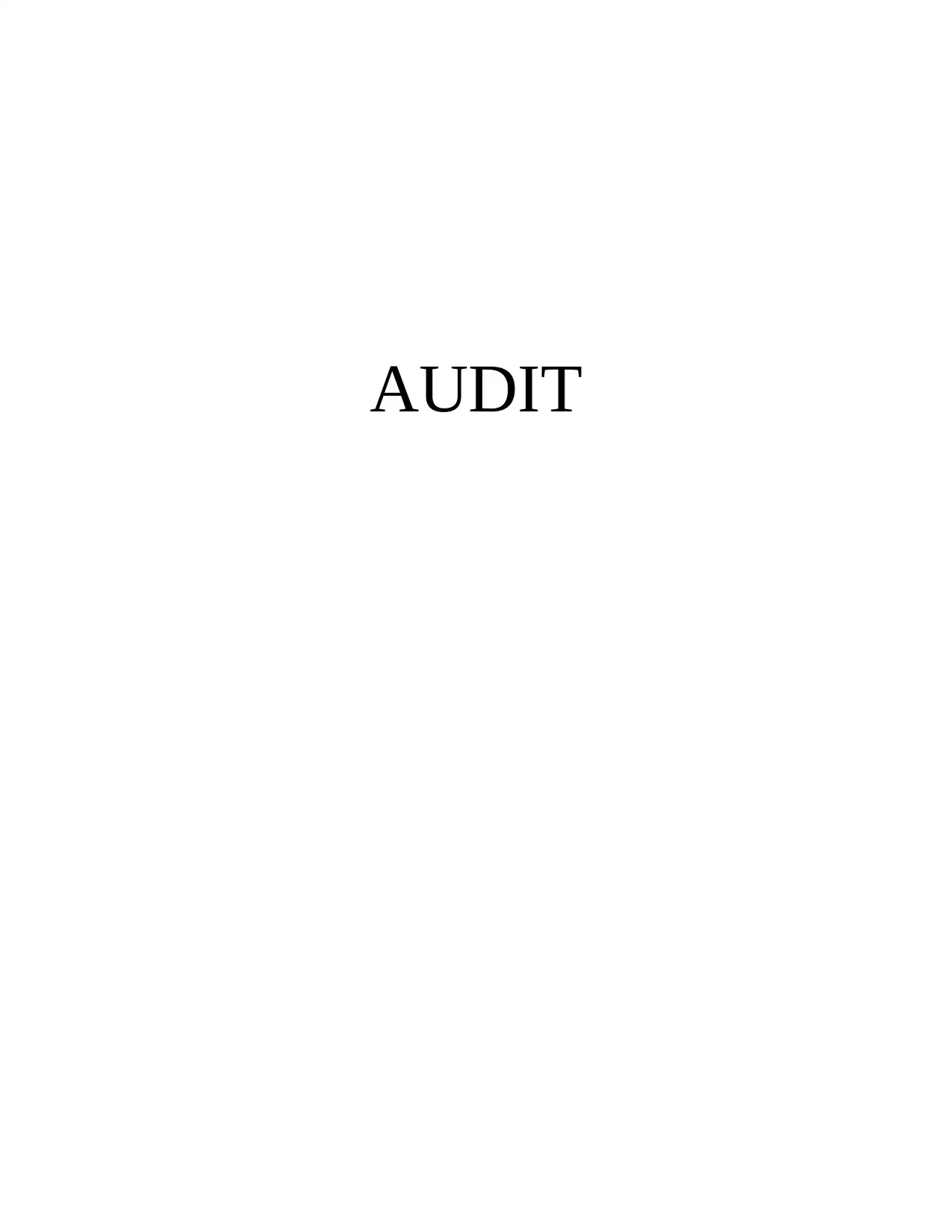
AUDIT
Paraphrase This Document
Need a fresh take? Get an instant paraphrase of this document with our AI Paraphraser
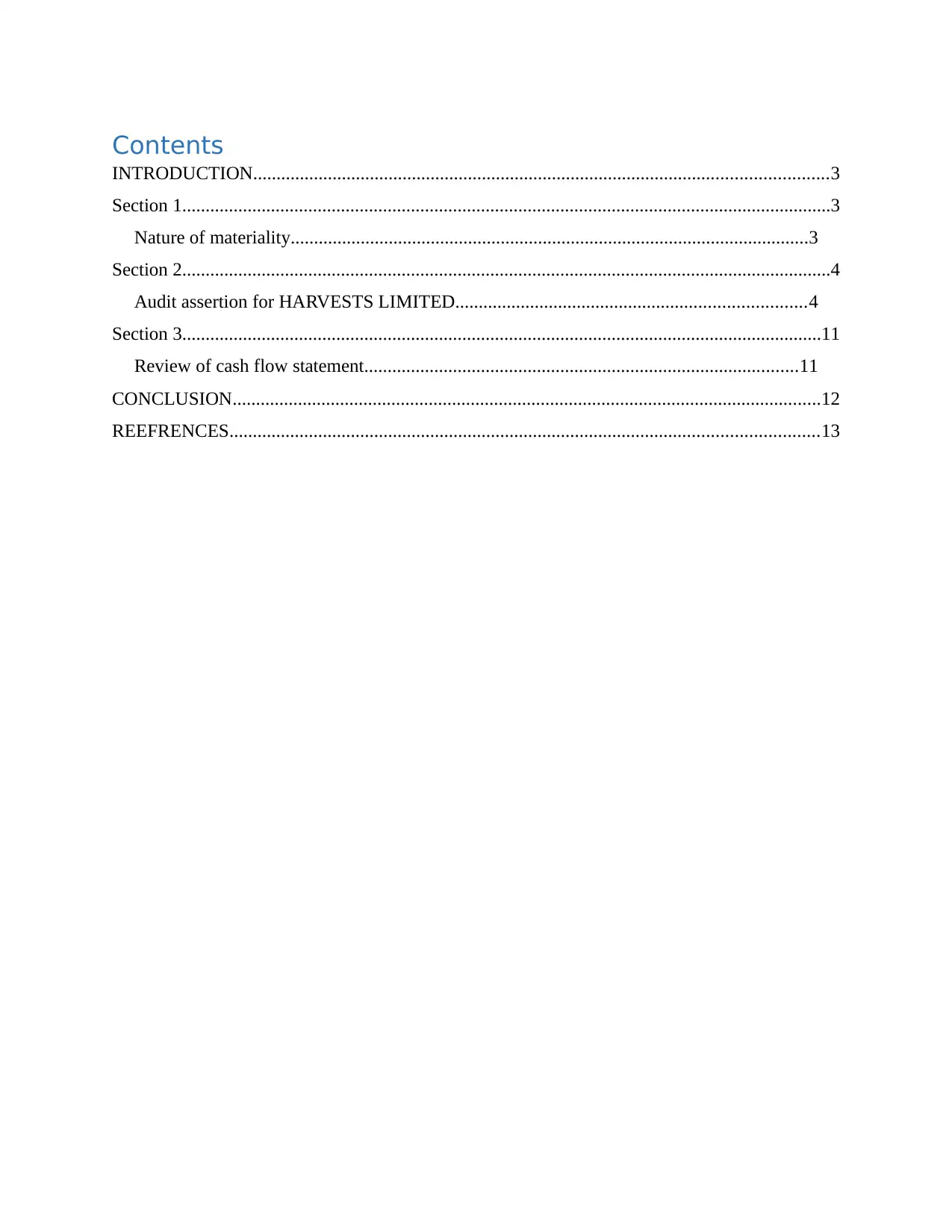
Contents
INTRODUCTION...........................................................................................................................3
Section 1...........................................................................................................................................3
Nature of materiality...............................................................................................................3
Section 2...........................................................................................................................................4
Audit assertion for HARVESTS LIMITED...........................................................................4
Section 3.........................................................................................................................................11
Review of cash flow statement.............................................................................................11
CONCLUSION..............................................................................................................................12
REEFRENCES..............................................................................................................................13
INTRODUCTION...........................................................................................................................3
Section 1...........................................................................................................................................3
Nature of materiality...............................................................................................................3
Section 2...........................................................................................................................................4
Audit assertion for HARVESTS LIMITED...........................................................................4
Section 3.........................................................................................................................................11
Review of cash flow statement.............................................................................................11
CONCLUSION..............................................................................................................................12
REEFRENCES..............................................................................................................................13
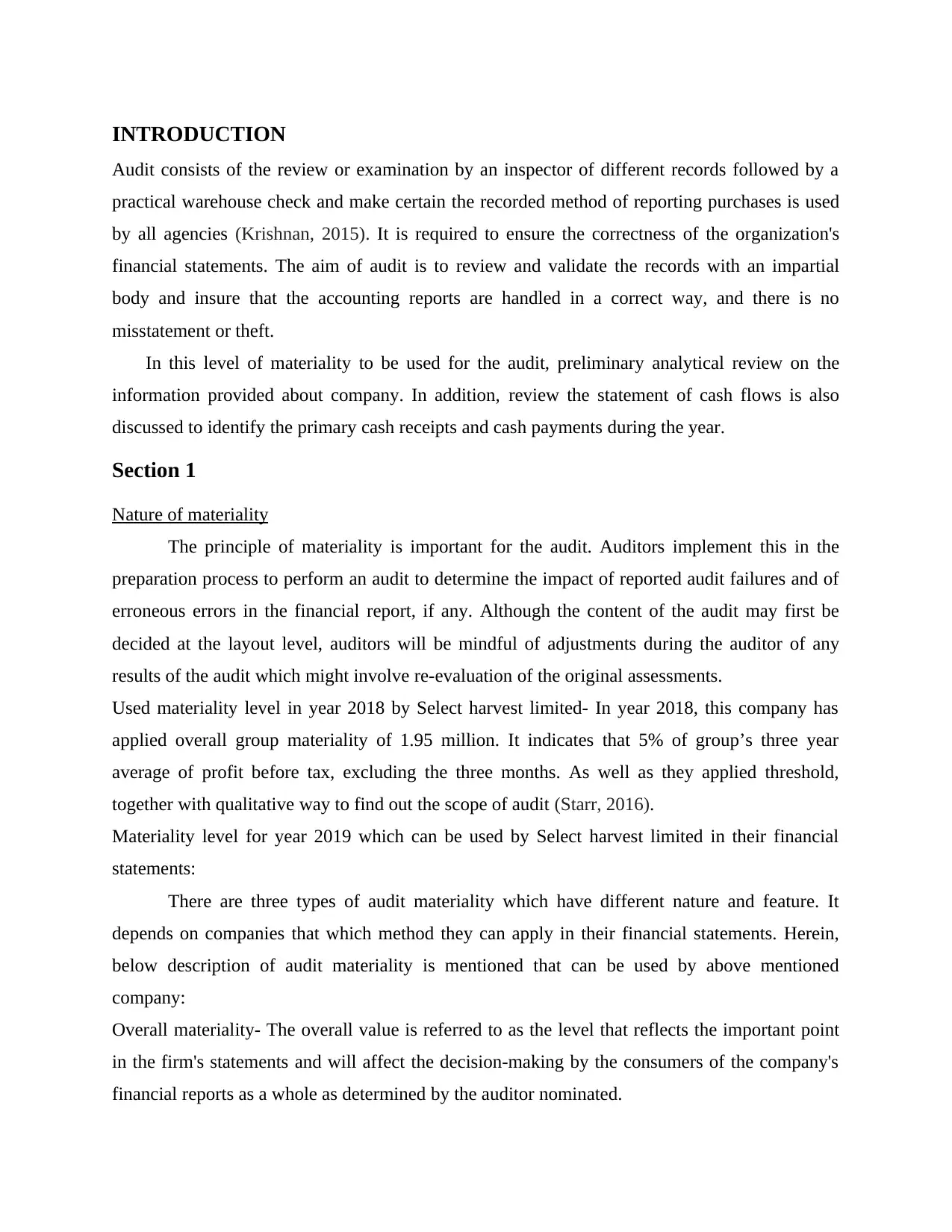
INTRODUCTION
Audit consists of the review or examination by an inspector of different records followed by a
practical warehouse check and make certain the recorded method of reporting purchases is used
by all agencies (Krishnan, 2015). It is required to ensure the correctness of the organization's
financial statements. The aim of audit is to review and validate the records with an impartial
body and insure that the accounting reports are handled in a correct way, and there is no
misstatement or theft.
In this level of materiality to be used for the audit, preliminary analytical review on the
information provided about company. In addition, review the statement of cash flows is also
discussed to identify the primary cash receipts and cash payments during the year.
Section 1
Nature of materiality
The principle of materiality is important for the audit. Auditors implement this in the
preparation process to perform an audit to determine the impact of reported audit failures and of
erroneous errors in the financial report, if any. Although the content of the audit may first be
decided at the layout level, auditors will be mindful of adjustments during the auditor of any
results of the audit which might involve re-evaluation of the original assessments.
Used materiality level in year 2018 by Select harvest limited- In year 2018, this company has
applied overall group materiality of 1.95 million. It indicates that 5% of group’s three year
average of profit before tax, excluding the three months. As well as they applied threshold,
together with qualitative way to find out the scope of audit (Starr, 2016).
Materiality level for year 2019 which can be used by Select harvest limited in their financial
statements:
There are three types of audit materiality which have different nature and feature. It
depends on companies that which method they can apply in their financial statements. Herein,
below description of audit materiality is mentioned that can be used by above mentioned
company:
Overall materiality- The overall value is referred to as the level that reflects the important point
in the firm's statements and will affect the decision-making by the consumers of the company's
financial reports as a whole as determined by the auditor nominated.
Audit consists of the review or examination by an inspector of different records followed by a
practical warehouse check and make certain the recorded method of reporting purchases is used
by all agencies (Krishnan, 2015). It is required to ensure the correctness of the organization's
financial statements. The aim of audit is to review and validate the records with an impartial
body and insure that the accounting reports are handled in a correct way, and there is no
misstatement or theft.
In this level of materiality to be used for the audit, preliminary analytical review on the
information provided about company. In addition, review the statement of cash flows is also
discussed to identify the primary cash receipts and cash payments during the year.
Section 1
Nature of materiality
The principle of materiality is important for the audit. Auditors implement this in the
preparation process to perform an audit to determine the impact of reported audit failures and of
erroneous errors in the financial report, if any. Although the content of the audit may first be
decided at the layout level, auditors will be mindful of adjustments during the auditor of any
results of the audit which might involve re-evaluation of the original assessments.
Used materiality level in year 2018 by Select harvest limited- In year 2018, this company has
applied overall group materiality of 1.95 million. It indicates that 5% of group’s three year
average of profit before tax, excluding the three months. As well as they applied threshold,
together with qualitative way to find out the scope of audit (Starr, 2016).
Materiality level for year 2019 which can be used by Select harvest limited in their financial
statements:
There are three types of audit materiality which have different nature and feature. It
depends on companies that which method they can apply in their financial statements. Herein,
below description of audit materiality is mentioned that can be used by above mentioned
company:
Overall materiality- The overall value is referred to as the level that reflects the important point
in the firm's statements and will affect the decision-making by the consumers of the company's
financial reports as a whole as determined by the auditor nominated.
⊘ This is a preview!⊘
Do you want full access?
Subscribe today to unlock all pages.

Trusted by 1+ million students worldwide
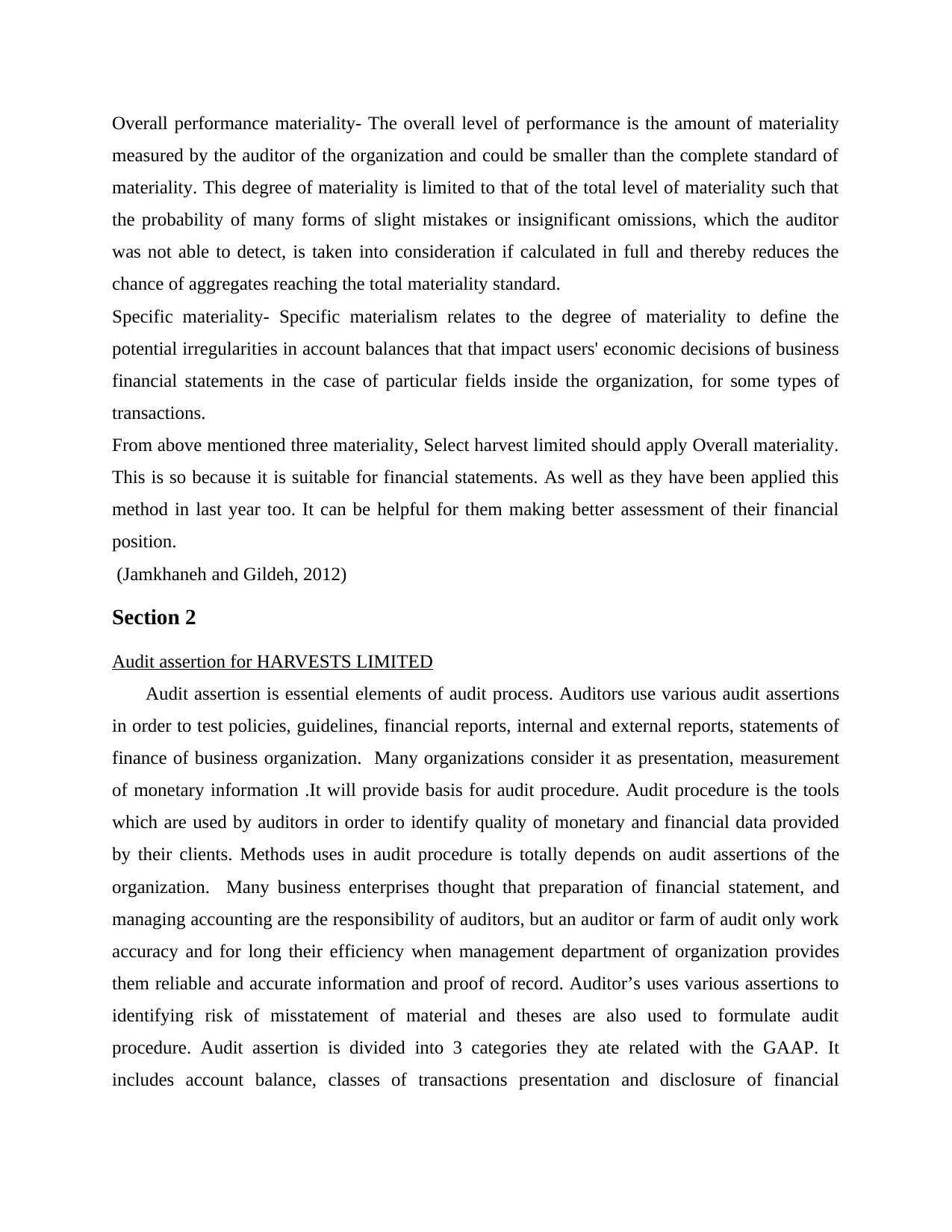
Overall performance materiality- The overall level of performance is the amount of materiality
measured by the auditor of the organization and could be smaller than the complete standard of
materiality. This degree of materiality is limited to that of the total level of materiality such that
the probability of many forms of slight mistakes or insignificant omissions, which the auditor
was not able to detect, is taken into consideration if calculated in full and thereby reduces the
chance of aggregates reaching the total materiality standard.
Specific materiality- Specific materialism relates to the degree of materiality to define the
potential irregularities in account balances that that impact users' economic decisions of business
financial statements in the case of particular fields inside the organization, for some types of
transactions.
From above mentioned three materiality, Select harvest limited should apply Overall materiality.
This is so because it is suitable for financial statements. As well as they have been applied this
method in last year too. It can be helpful for them making better assessment of their financial
position.
(Jamkhaneh and Gildeh, 2012)
Section 2
Audit assertion for HARVESTS LIMITED
Audit assertion is essential elements of audit process. Auditors use various audit assertions
in order to test policies, guidelines, financial reports, internal and external reports, statements of
finance of business organization. Many organizations consider it as presentation, measurement
of monetary information .It will provide basis for audit procedure. Audit procedure is the tools
which are used by auditors in order to identify quality of monetary and financial data provided
by their clients. Methods uses in audit procedure is totally depends on audit assertions of the
organization. Many business enterprises thought that preparation of financial statement, and
managing accounting are the responsibility of auditors, but an auditor or farm of audit only work
accuracy and for long their efficiency when management department of organization provides
them reliable and accurate information and proof of record. Auditor’s uses various assertions to
identifying risk of misstatement of material and theses are also used to formulate audit
procedure. Audit assertion is divided into 3 categories they ate related with the GAAP. It
includes account balance, classes of transactions presentation and disclosure of financial
measured by the auditor of the organization and could be smaller than the complete standard of
materiality. This degree of materiality is limited to that of the total level of materiality such that
the probability of many forms of slight mistakes or insignificant omissions, which the auditor
was not able to detect, is taken into consideration if calculated in full and thereby reduces the
chance of aggregates reaching the total materiality standard.
Specific materiality- Specific materialism relates to the degree of materiality to define the
potential irregularities in account balances that that impact users' economic decisions of business
financial statements in the case of particular fields inside the organization, for some types of
transactions.
From above mentioned three materiality, Select harvest limited should apply Overall materiality.
This is so because it is suitable for financial statements. As well as they have been applied this
method in last year too. It can be helpful for them making better assessment of their financial
position.
(Jamkhaneh and Gildeh, 2012)
Section 2
Audit assertion for HARVESTS LIMITED
Audit assertion is essential elements of audit process. Auditors use various audit assertions
in order to test policies, guidelines, financial reports, internal and external reports, statements of
finance of business organization. Many organizations consider it as presentation, measurement
of monetary information .It will provide basis for audit procedure. Audit procedure is the tools
which are used by auditors in order to identify quality of monetary and financial data provided
by their clients. Methods uses in audit procedure is totally depends on audit assertions of the
organization. Many business enterprises thought that preparation of financial statement, and
managing accounting are the responsibility of auditors, but an auditor or farm of audit only work
accuracy and for long their efficiency when management department of organization provides
them reliable and accurate information and proof of record. Auditor’s uses various assertions to
identifying risk of misstatement of material and theses are also used to formulate audit
procedure. Audit assertion is divided into 3 categories they ate related with the GAAP. It
includes account balance, classes of transactions presentation and disclosure of financial
Paraphrase This Document
Need a fresh take? Get an instant paraphrase of this document with our AI Paraphraser
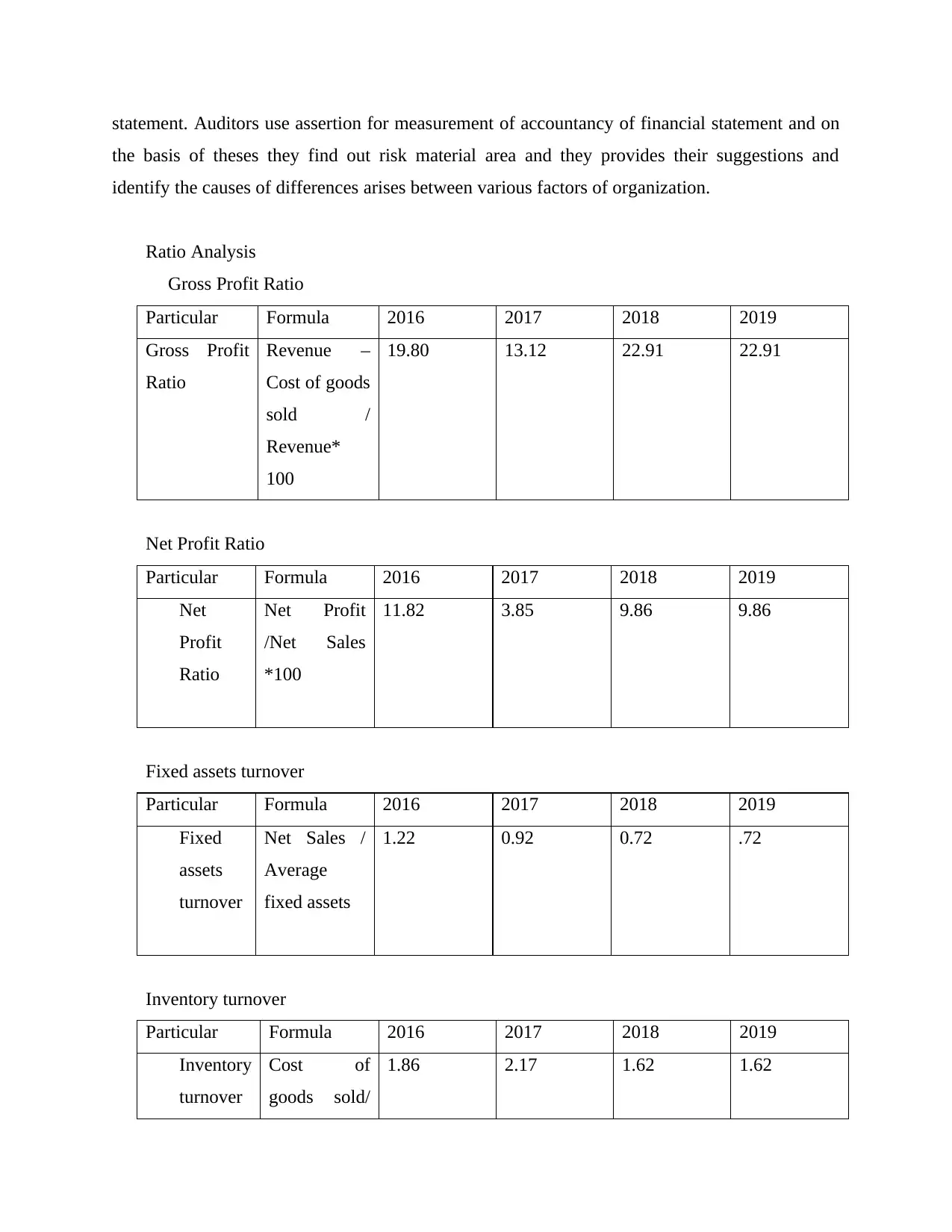
statement. Auditors use assertion for measurement of accountancy of financial statement and on
the basis of theses they find out risk material area and they provides their suggestions and
identify the causes of differences arises between various factors of organization.
Ratio Analysis
Gross Profit Ratio
Particular Formula 2016 2017 2018 2019
Gross Profit
Ratio
Revenue –
Cost of goods
sold /
Revenue*
100
19.80 13.12 22.91 22.91
Net Profit Ratio
Particular Formula 2016 2017 2018 2019
Net
Profit
Ratio
Net Profit
/Net Sales
*100
11.82 3.85 9.86 9.86
Fixed assets turnover
Particular Formula 2016 2017 2018 2019
Fixed
assets
turnover
Net Sales /
Average
fixed assets
1.22 0.92 0.72 .72
Inventory turnover
Particular Formula 2016 2017 2018 2019
Inventory
turnover
Cost of
goods sold/
1.86 2.17 1.62 1.62
the basis of theses they find out risk material area and they provides their suggestions and
identify the causes of differences arises between various factors of organization.
Ratio Analysis
Gross Profit Ratio
Particular Formula 2016 2017 2018 2019
Gross Profit
Ratio
Revenue –
Cost of goods
sold /
Revenue*
100
19.80 13.12 22.91 22.91
Net Profit Ratio
Particular Formula 2016 2017 2018 2019
Net
Profit
Ratio
Net Profit
/Net Sales
*100
11.82 3.85 9.86 9.86
Fixed assets turnover
Particular Formula 2016 2017 2018 2019
Fixed
assets
turnover
Net Sales /
Average
fixed assets
1.22 0.92 0.72 .72
Inventory turnover
Particular Formula 2016 2017 2018 2019
Inventory
turnover
Cost of
goods sold/
1.86 2.17 1.62 1.62
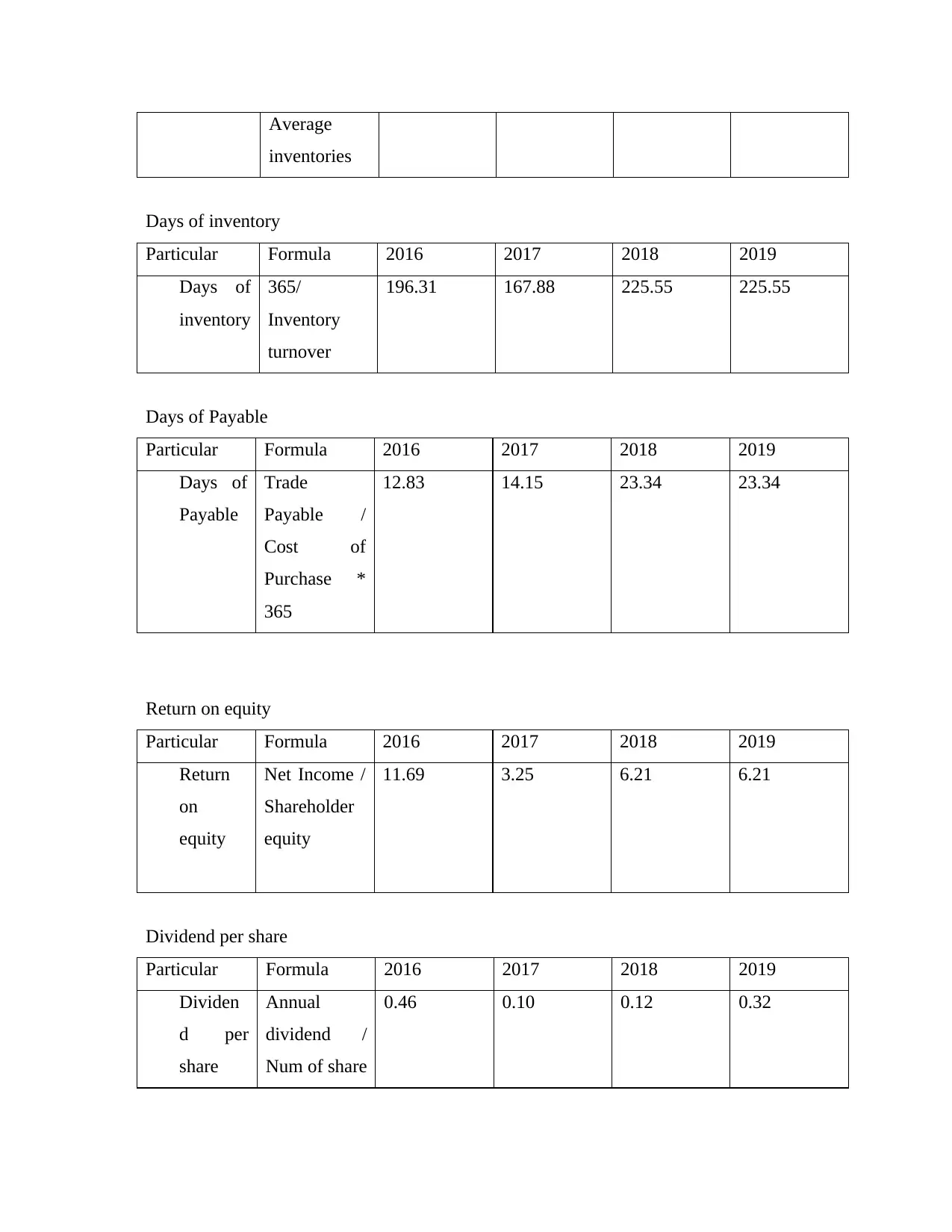
Average
inventories
Days of inventory
Particular Formula 2016 2017 2018 2019
Days of
inventory
365/
Inventory
turnover
196.31 167.88 225.55 225.55
Days of Payable
Particular Formula 2016 2017 2018 2019
Days of
Payable
Trade
Payable /
Cost of
Purchase *
365
12.83 14.15 23.34 23.34
Return on equity
Particular Formula 2016 2017 2018 2019
Return
on
equity
Net Income /
Shareholder
equity
11.69 3.25 6.21 6.21
Dividend per share
Particular Formula 2016 2017 2018 2019
Dividen
d per
share
Annual
dividend /
Num of share
0.46 0.10 0.12 0.32
inventories
Days of inventory
Particular Formula 2016 2017 2018 2019
Days of
inventory
365/
Inventory
turnover
196.31 167.88 225.55 225.55
Days of Payable
Particular Formula 2016 2017 2018 2019
Days of
Payable
Trade
Payable /
Cost of
Purchase *
365
12.83 14.15 23.34 23.34
Return on equity
Particular Formula 2016 2017 2018 2019
Return
on
equity
Net Income /
Shareholder
equity
11.69 3.25 6.21 6.21
Dividend per share
Particular Formula 2016 2017 2018 2019
Dividen
d per
share
Annual
dividend /
Num of share
0.46 0.10 0.12 0.32
⊘ This is a preview!⊘
Do you want full access?
Subscribe today to unlock all pages.

Trusted by 1+ million students worldwide
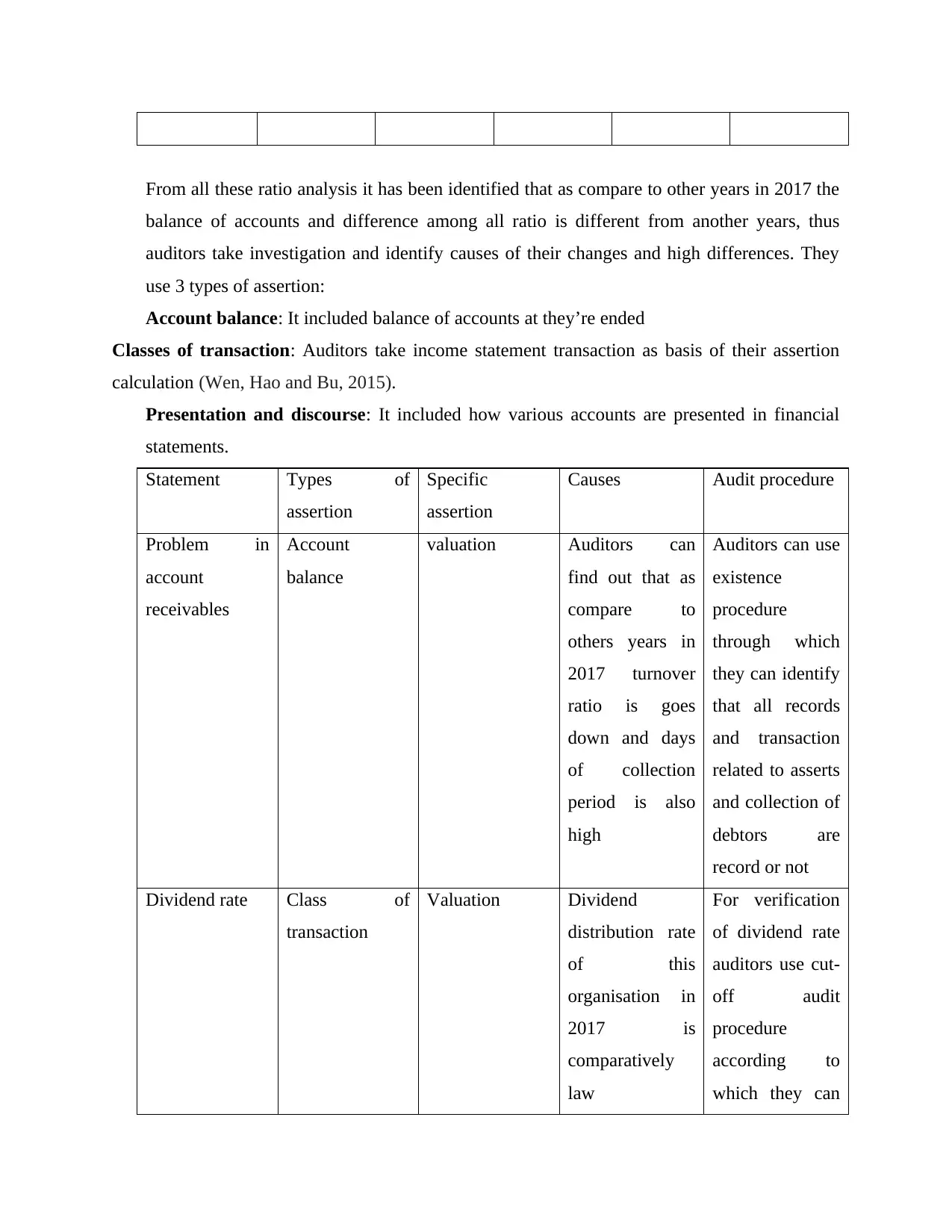
From all these ratio analysis it has been identified that as compare to other years in 2017 the
balance of accounts and difference among all ratio is different from another years, thus
auditors take investigation and identify causes of their changes and high differences. They
use 3 types of assertion:
Account balance: It included balance of accounts at they’re ended
Classes of transaction: Auditors take income statement transaction as basis of their assertion
calculation (Wen, Hao and Bu, 2015).
Presentation and discourse: It included how various accounts are presented in financial
statements.
Statement Types of
assertion
Specific
assertion
Causes Audit procedure
Problem in
account
receivables
Account
balance
valuation Auditors can
find out that as
compare to
others years in
2017 turnover
ratio is goes
down and days
of collection
period is also
high
Auditors can use
existence
procedure
through which
they can identify
that all records
and transaction
related to asserts
and collection of
debtors are
record or not
Dividend rate Class of
transaction
Valuation Dividend
distribution rate
of this
organisation in
2017 is
comparatively
law
For verification
of dividend rate
auditors use cut-
off audit
procedure
according to
which they can
balance of accounts and difference among all ratio is different from another years, thus
auditors take investigation and identify causes of their changes and high differences. They
use 3 types of assertion:
Account balance: It included balance of accounts at they’re ended
Classes of transaction: Auditors take income statement transaction as basis of their assertion
calculation (Wen, Hao and Bu, 2015).
Presentation and discourse: It included how various accounts are presented in financial
statements.
Statement Types of
assertion
Specific
assertion
Causes Audit procedure
Problem in
account
receivables
Account
balance
valuation Auditors can
find out that as
compare to
others years in
2017 turnover
ratio is goes
down and days
of collection
period is also
high
Auditors can use
existence
procedure
through which
they can identify
that all records
and transaction
related to asserts
and collection of
debtors are
record or not
Dividend rate Class of
transaction
Valuation Dividend
distribution rate
of this
organisation in
2017 is
comparatively
law
For verification
of dividend rate
auditors use cut-
off audit
procedure
according to
which they can
Paraphrase This Document
Need a fresh take? Get an instant paraphrase of this document with our AI Paraphraser
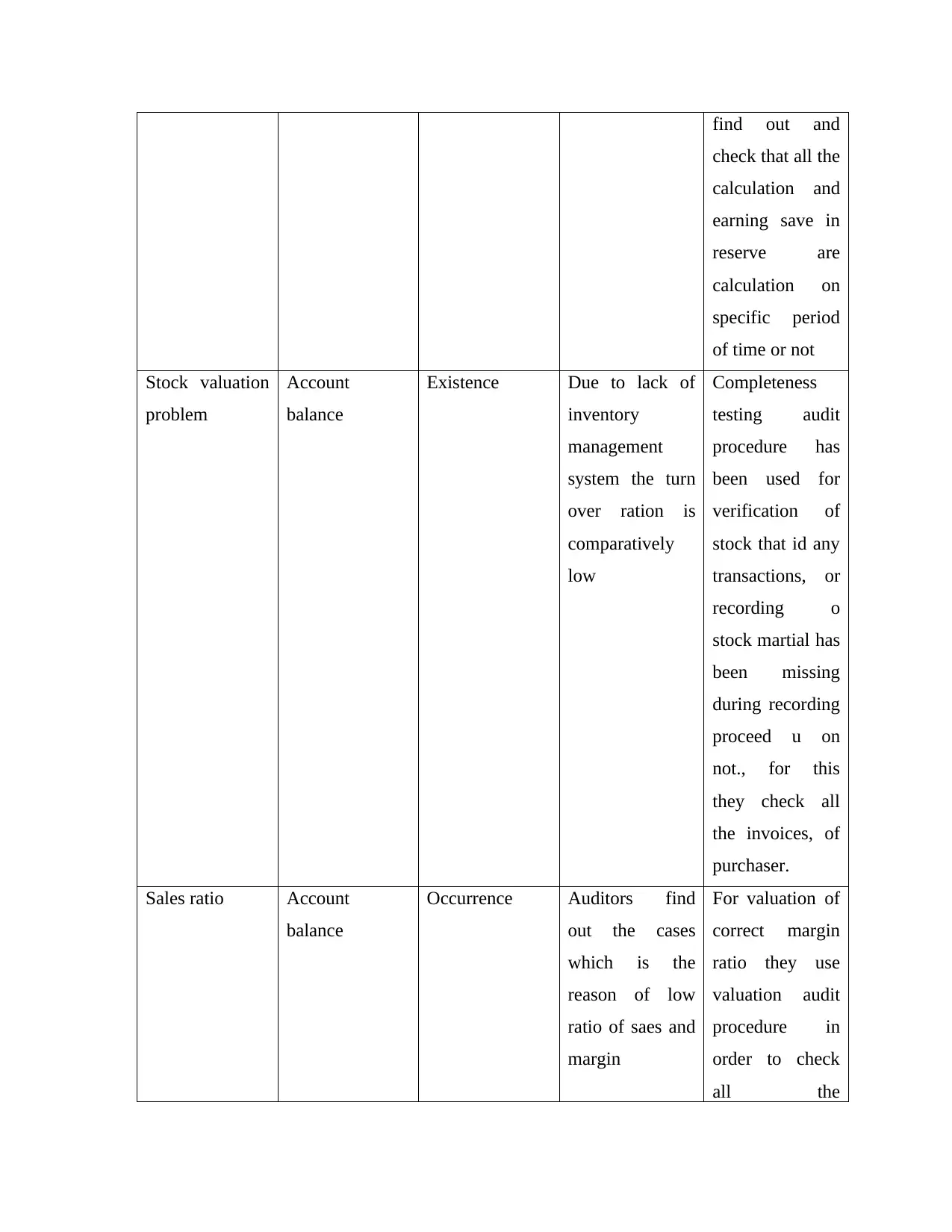
find out and
check that all the
calculation and
earning save in
reserve are
calculation on
specific period
of time or not
Stock valuation
problem
Account
balance
Existence Due to lack of
inventory
management
system the turn
over ration is
comparatively
low
Completeness
testing audit
procedure has
been used for
verification of
stock that id any
transactions, or
recording o
stock martial has
been missing
during recording
proceed u on
not., for this
they check all
the invoices, of
purchaser.
Sales ratio Account
balance
Occurrence Auditors find
out the cases
which is the
reason of low
ratio of saes and
margin
For valuation of
correct margin
ratio they use
valuation audit
procedure in
order to check
all the
check that all the
calculation and
earning save in
reserve are
calculation on
specific period
of time or not
Stock valuation
problem
Account
balance
Existence Due to lack of
inventory
management
system the turn
over ration is
comparatively
low
Completeness
testing audit
procedure has
been used for
verification of
stock that id any
transactions, or
recording o
stock martial has
been missing
during recording
proceed u on
not., for this
they check all
the invoices, of
purchaser.
Sales ratio Account
balance
Occurrence Auditors find
out the cases
which is the
reason of low
ratio of saes and
margin
For valuation of
correct margin
ratio they use
valuation audit
procedure in
order to check
all the
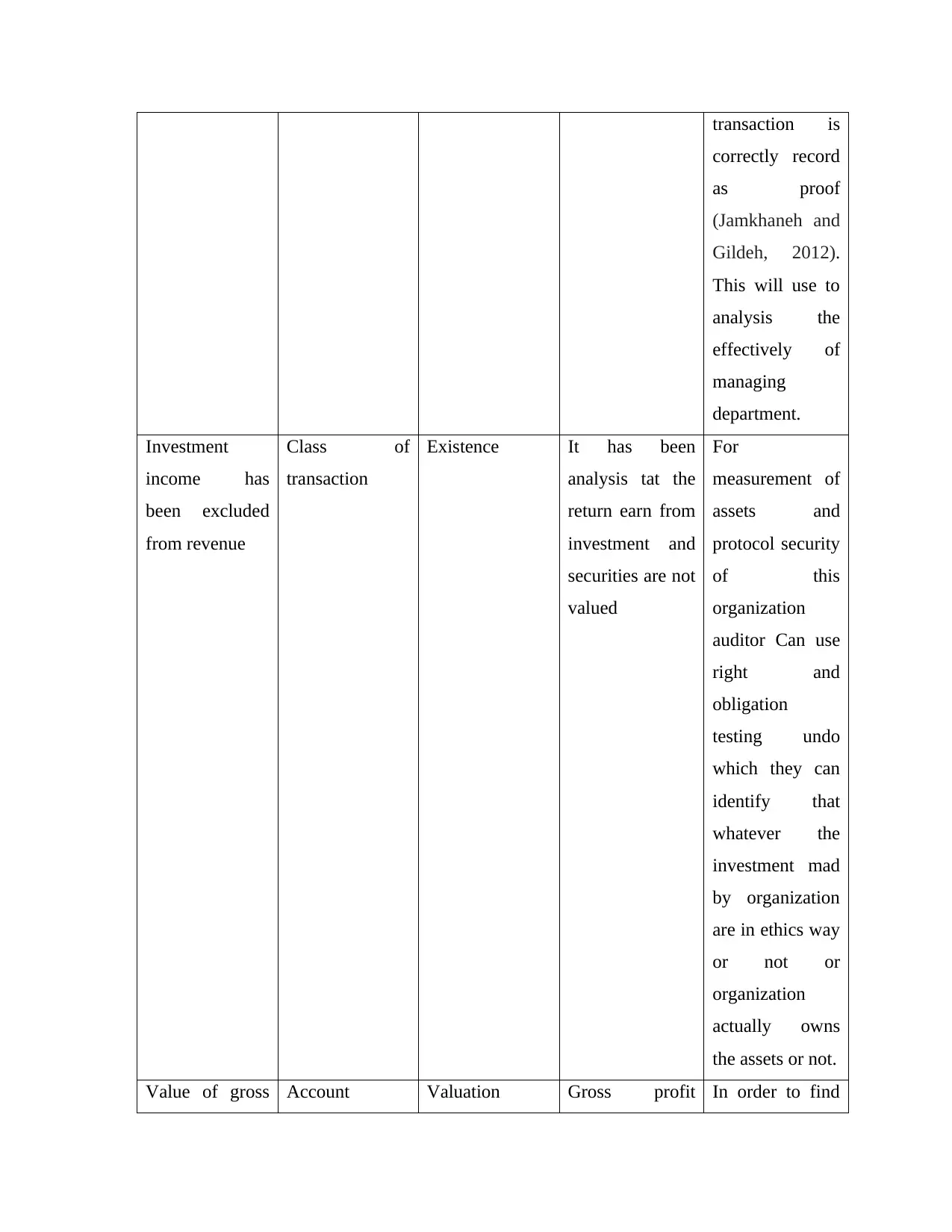
transaction is
correctly record
as proof
(Jamkhaneh and
Gildeh, 2012).
This will use to
analysis the
effectively of
managing
department.
Investment
income has
been excluded
from revenue
Class of
transaction
Existence It has been
analysis tat the
return earn from
investment and
securities are not
valued
For
measurement of
assets and
protocol security
of this
organization
auditor Can use
right and
obligation
testing undo
which they can
identify that
whatever the
investment mad
by organization
are in ethics way
or not or
organization
actually owns
the assets or not.
Value of gross Account Valuation Gross profit In order to find
correctly record
as proof
(Jamkhaneh and
Gildeh, 2012).
This will use to
analysis the
effectively of
managing
department.
Investment
income has
been excluded
from revenue
Class of
transaction
Existence It has been
analysis tat the
return earn from
investment and
securities are not
valued
For
measurement of
assets and
protocol security
of this
organization
auditor Can use
right and
obligation
testing undo
which they can
identify that
whatever the
investment mad
by organization
are in ethics way
or not or
organization
actually owns
the assets or not.
Value of gross Account Valuation Gross profit In order to find
⊘ This is a preview!⊘
Do you want full access?
Subscribe today to unlock all pages.

Trusted by 1+ million students worldwide
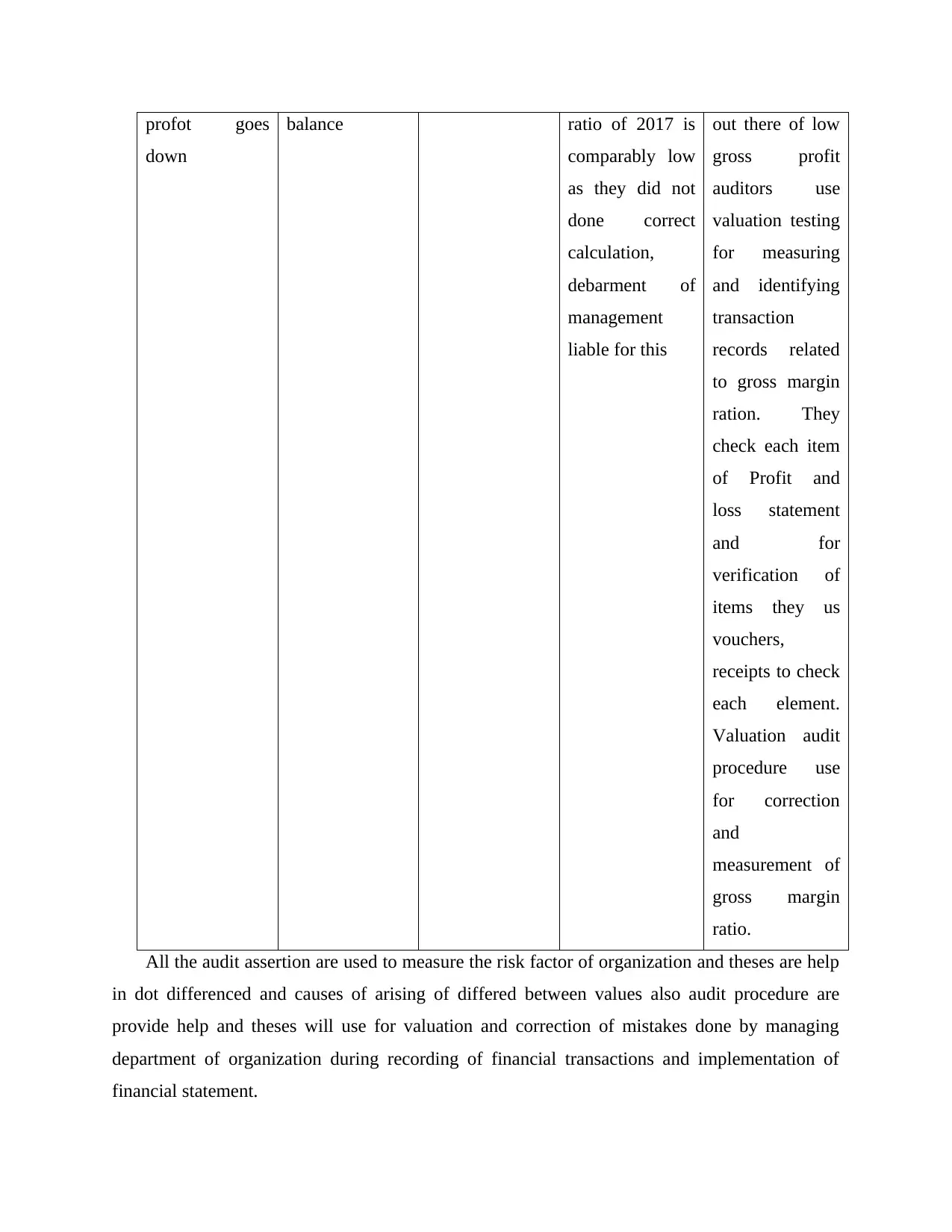
profot goes
down
balance ratio of 2017 is
comparably low
as they did not
done correct
calculation,
debarment of
management
liable for this
out there of low
gross profit
auditors use
valuation testing
for measuring
and identifying
transaction
records related
to gross margin
ration. They
check each item
of Profit and
loss statement
and for
verification of
items they us
vouchers,
receipts to check
each element.
Valuation audit
procedure use
for correction
and
measurement of
gross margin
ratio.
All the audit assertion are used to measure the risk factor of organization and theses are help
in dot differenced and causes of arising of differed between values also audit procedure are
provide help and theses will use for valuation and correction of mistakes done by managing
department of organization during recording of financial transactions and implementation of
financial statement.
down
balance ratio of 2017 is
comparably low
as they did not
done correct
calculation,
debarment of
management
liable for this
out there of low
gross profit
auditors use
valuation testing
for measuring
and identifying
transaction
records related
to gross margin
ration. They
check each item
of Profit and
loss statement
and for
verification of
items they us
vouchers,
receipts to check
each element.
Valuation audit
procedure use
for correction
and
measurement of
gross margin
ratio.
All the audit assertion are used to measure the risk factor of organization and theses are help
in dot differenced and causes of arising of differed between values also audit procedure are
provide help and theses will use for valuation and correction of mistakes done by managing
department of organization during recording of financial transactions and implementation of
financial statement.
Paraphrase This Document
Need a fresh take? Get an instant paraphrase of this document with our AI Paraphraser
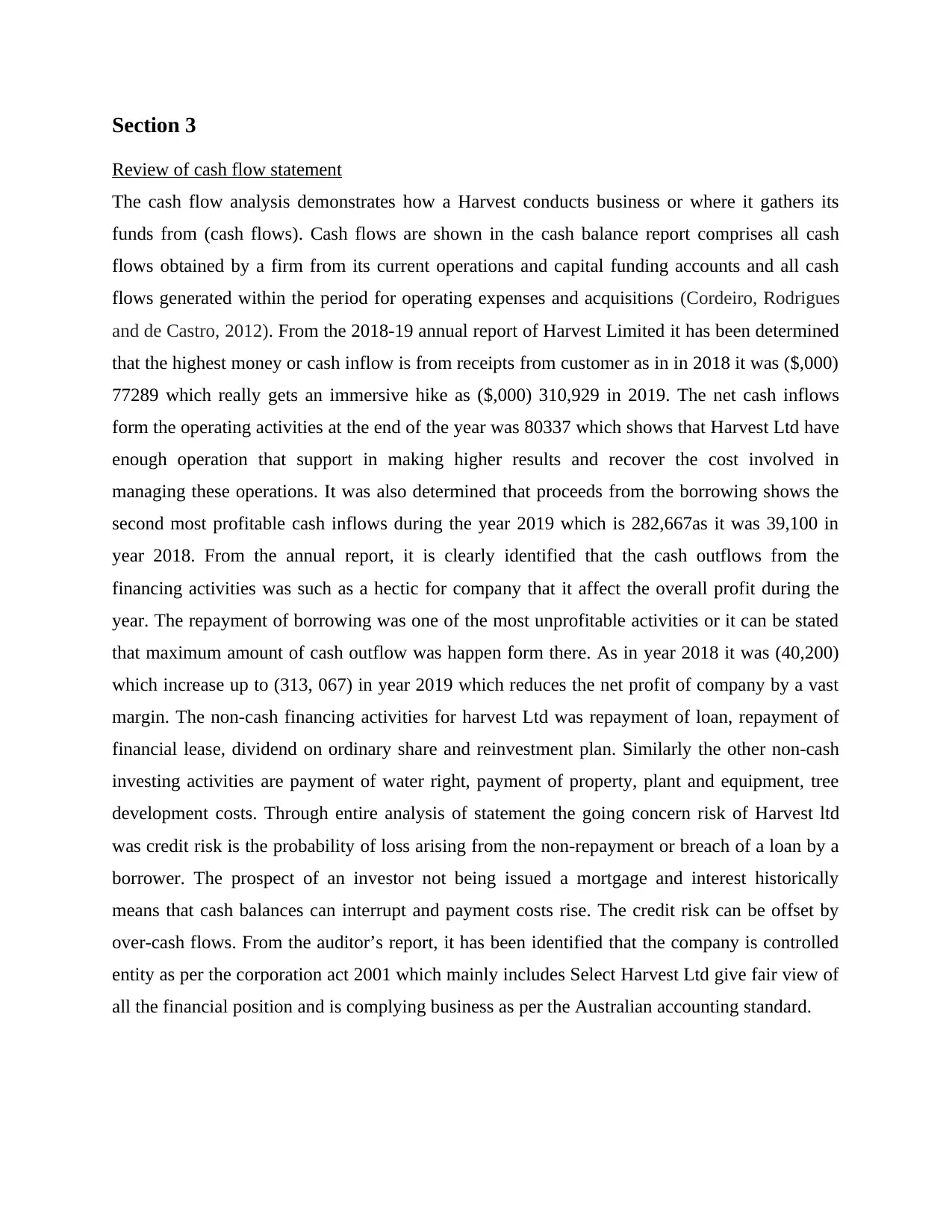
Section 3
Review of cash flow statement
The cash flow analysis demonstrates how a Harvest conducts business or where it gathers its
funds from (cash flows). Cash flows are shown in the cash balance report comprises all cash
flows obtained by a firm from its current operations and capital funding accounts and all cash
flows generated within the period for operating expenses and acquisitions (Cordeiro, Rodrigues
and de Castro, 2012). From the 2018-19 annual report of Harvest Limited it has been determined
that the highest money or cash inflow is from receipts from customer as in in 2018 it was ($,000)
77289 which really gets an immersive hike as ($,000) 310,929 in 2019. The net cash inflows
form the operating activities at the end of the year was 80337 which shows that Harvest Ltd have
enough operation that support in making higher results and recover the cost involved in
managing these operations. It was also determined that proceeds from the borrowing shows the
second most profitable cash inflows during the year 2019 which is 282,667as it was 39,100 in
year 2018. From the annual report, it is clearly identified that the cash outflows from the
financing activities was such as a hectic for company that it affect the overall profit during the
year. The repayment of borrowing was one of the most unprofitable activities or it can be stated
that maximum amount of cash outflow was happen form there. As in year 2018 it was (40,200)
which increase up to (313, 067) in year 2019 which reduces the net profit of company by a vast
margin. The non-cash financing activities for harvest Ltd was repayment of loan, repayment of
financial lease, dividend on ordinary share and reinvestment plan. Similarly the other non-cash
investing activities are payment of water right, payment of property, plant and equipment, tree
development costs. Through entire analysis of statement the going concern risk of Harvest ltd
was credit risk is the probability of loss arising from the non-repayment or breach of a loan by a
borrower. The prospect of an investor not being issued a mortgage and interest historically
means that cash balances can interrupt and payment costs rise. The credit risk can be offset by
over-cash flows. From the auditor’s report, it has been identified that the company is controlled
entity as per the corporation act 2001 which mainly includes Select Harvest Ltd give fair view of
all the financial position and is complying business as per the Australian accounting standard.
Review of cash flow statement
The cash flow analysis demonstrates how a Harvest conducts business or where it gathers its
funds from (cash flows). Cash flows are shown in the cash balance report comprises all cash
flows obtained by a firm from its current operations and capital funding accounts and all cash
flows generated within the period for operating expenses and acquisitions (Cordeiro, Rodrigues
and de Castro, 2012). From the 2018-19 annual report of Harvest Limited it has been determined
that the highest money or cash inflow is from receipts from customer as in in 2018 it was ($,000)
77289 which really gets an immersive hike as ($,000) 310,929 in 2019. The net cash inflows
form the operating activities at the end of the year was 80337 which shows that Harvest Ltd have
enough operation that support in making higher results and recover the cost involved in
managing these operations. It was also determined that proceeds from the borrowing shows the
second most profitable cash inflows during the year 2019 which is 282,667as it was 39,100 in
year 2018. From the annual report, it is clearly identified that the cash outflows from the
financing activities was such as a hectic for company that it affect the overall profit during the
year. The repayment of borrowing was one of the most unprofitable activities or it can be stated
that maximum amount of cash outflow was happen form there. As in year 2018 it was (40,200)
which increase up to (313, 067) in year 2019 which reduces the net profit of company by a vast
margin. The non-cash financing activities for harvest Ltd was repayment of loan, repayment of
financial lease, dividend on ordinary share and reinvestment plan. Similarly the other non-cash
investing activities are payment of water right, payment of property, plant and equipment, tree
development costs. Through entire analysis of statement the going concern risk of Harvest ltd
was credit risk is the probability of loss arising from the non-repayment or breach of a loan by a
borrower. The prospect of an investor not being issued a mortgage and interest historically
means that cash balances can interrupt and payment costs rise. The credit risk can be offset by
over-cash flows. From the auditor’s report, it has been identified that the company is controlled
entity as per the corporation act 2001 which mainly includes Select Harvest Ltd give fair view of
all the financial position and is complying business as per the Australian accounting standard.
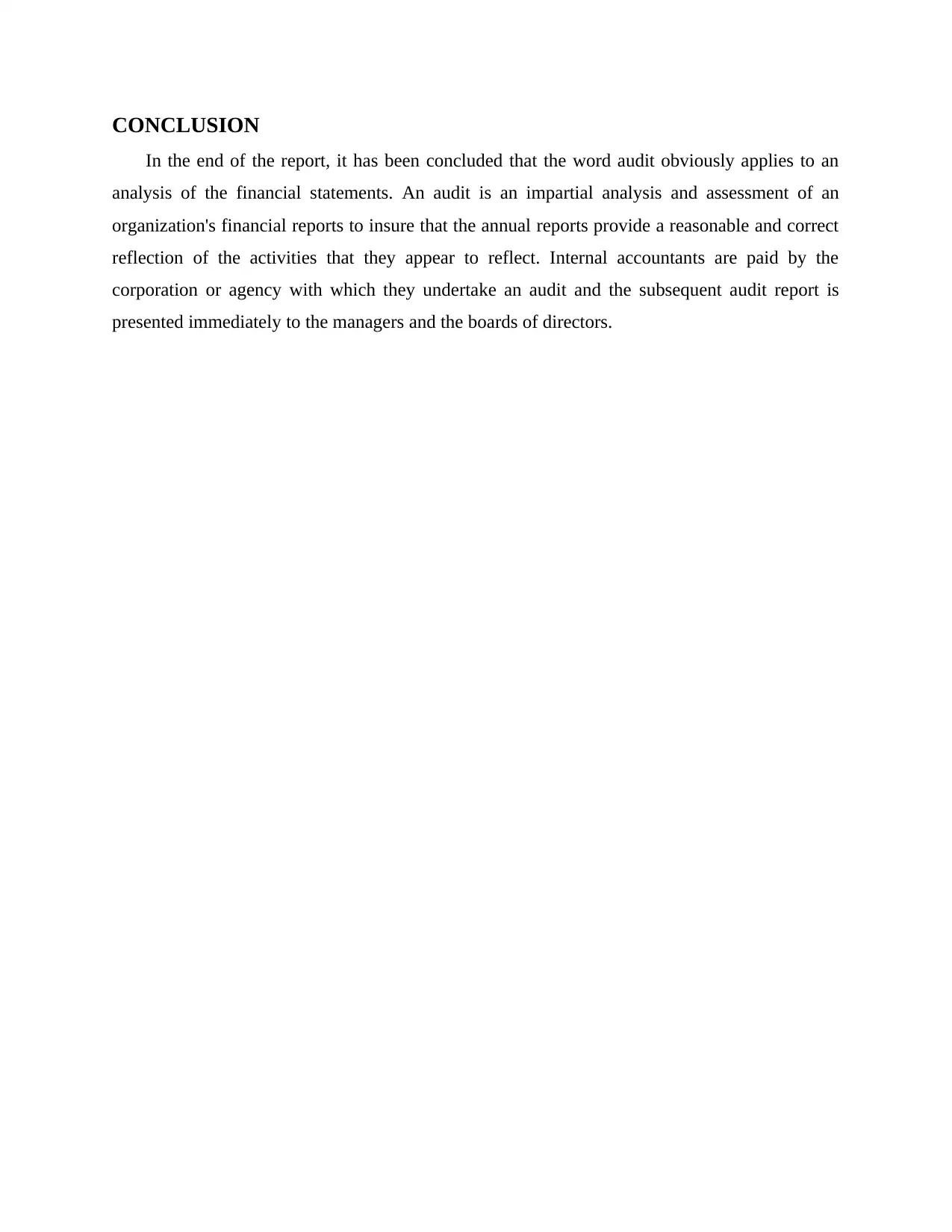
CONCLUSION
In the end of the report, it has been concluded that the word audit obviously applies to an
analysis of the financial statements. An audit is an impartial analysis and assessment of an
organization's financial reports to insure that the annual reports provide a reasonable and correct
reflection of the activities that they appear to reflect. Internal accountants are paid by the
corporation or agency with which they undertake an audit and the subsequent audit report is
presented immediately to the managers and the boards of directors.
In the end of the report, it has been concluded that the word audit obviously applies to an
analysis of the financial statements. An audit is an impartial analysis and assessment of an
organization's financial reports to insure that the annual reports provide a reasonable and correct
reflection of the activities that they appear to reflect. Internal accountants are paid by the
corporation or agency with which they undertake an audit and the subsequent audit report is
presented immediately to the managers and the boards of directors.
⊘ This is a preview!⊘
Do you want full access?
Subscribe today to unlock all pages.

Trusted by 1+ million students worldwide
1 out of 13
Related Documents
Your All-in-One AI-Powered Toolkit for Academic Success.
+13062052269
info@desklib.com
Available 24*7 on WhatsApp / Email
![[object Object]](/_next/static/media/star-bottom.7253800d.svg)
Unlock your academic potential
Copyright © 2020–2025 A2Z Services. All Rights Reserved. Developed and managed by ZUCOL.





